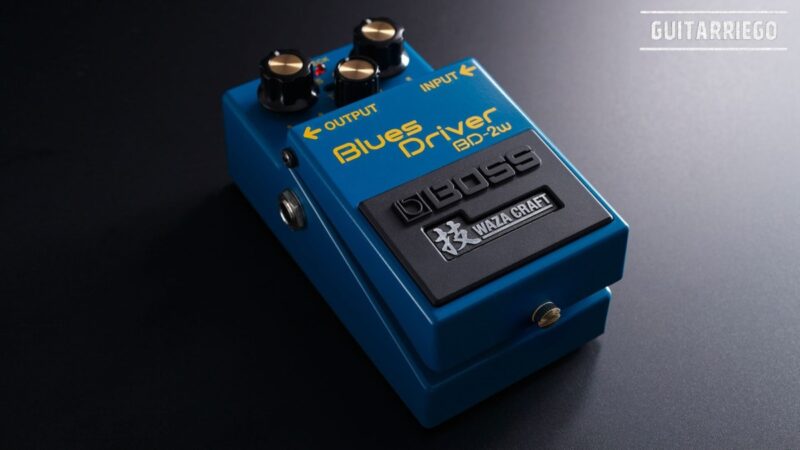Pink Floyd and the secrets of the Gilmour vs Waters rivalry
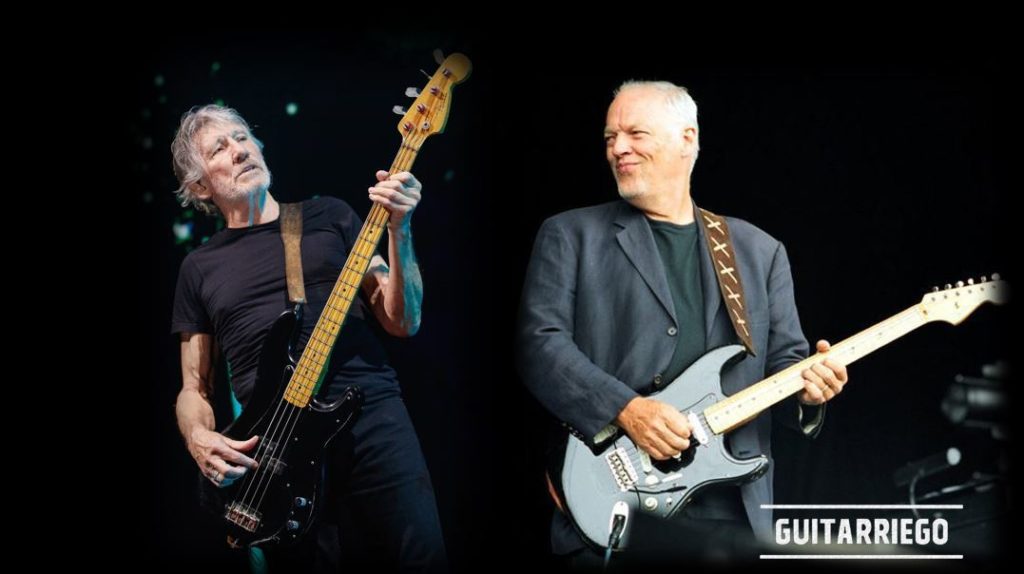
David Gilmour vs Roger Waters, one of rock’s greatest rivalries, partners and rivals in one of the most important bands, Pink Floyd.
40 years after The Wall tour
In 1980, when Pink Floyd toured The Wall, the four members of the band were seen only during concerts. Offstage, each member moved independently, avoiding crossing. Nick Mason, drummer and co-founder of Pink Floyd, says they each had their own dressing room.
In his book Inside Out: A Personal History of Pink Floyd -Inside out: a personal history of Pink Floyd-, he recounts the friction in the band, not just David Gilmour vs. Roger Waters.
“Both Roger’s – Waters, bassist and leader – and Rick’s – Wright, keyboardist – were at opposite ends, I think we all threw separate parties after concerts, carefully avoiding inviting each other.” They arrived at the stadiums separately, and their drivers were instructed to park strategically in a circle, with the doors facing outward, eliminating eye contact between the musicians. Wright, fired shortly before, was a paid musician, and in fact he was the only one who made money from the tour.

Pink Floyd, a fight of egos
The fight of egos was one of the characteristics that marked the series of concerts of the presentation of the album The wall. The tour began on February 7, 1980 at the Memorial Sports Arena in Los Angeles, United States. This tour defined the definitive estrangement of Roger Waters, bassist, singer and songwriter with the rest of the band. However, David Gilmour, guitarist and singer represented Roger’s nemesis, definitely marking the Gilmour vs Waters rivalry.
Pink Floyd and the absurd bombast
A hallmark of the band was the absurd bombast of 1970s rock. Already questioned since 1977 for the simplicity of punk music, with its greatest exponents being the Ramones in the United States and the Sex Pistols in the United Kingdom.
So ambitious was his staging that it required excessive travel times from city to city. This meant that they only performed in four cities: Los Angeles and Uniondale in the United States, Dortmund in Germany and London in the United Kingdom. In each place they offered several concerts, thus in total, The wall was played 31 times live.
The erosion of Roger Waters’ relationship with the band
The attrition of the group had reached its maximum point during the recording of the disc of The Wall. Waters’ progressive advance over his groupmates had been consummated in Animals in 1977. On that album, Roger Water composed all the pieces except for Dogs, which was made half with David Gilmour.
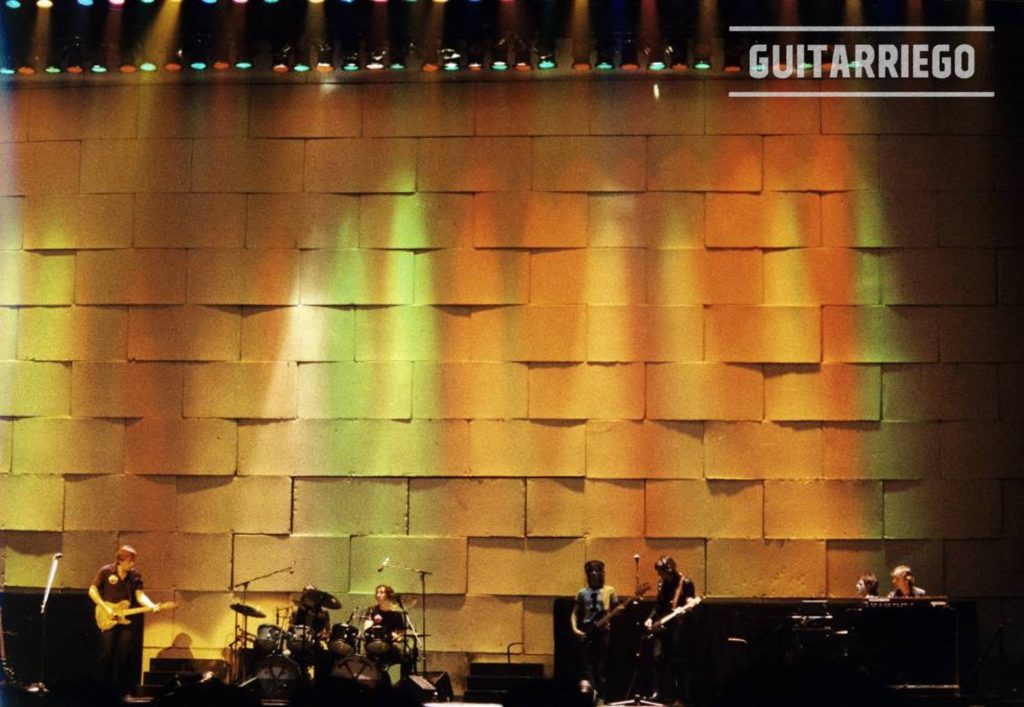
Waters thought his teammates were lazy and mediocre. While the rest of the band viewed Roger as a tyrant, he ran Pink Floyd at will.
The Wall: Pink Floyd or Roger Waters soloist?
In July 1978, Roger Waters summoned the band to the Britannia Row studios in London, and gave them a choice between the demos of two albums that the bassist had just composed, the one chosen was The wall. The discarded album would be Waters’ first solo album, The Pros and Cons of Hitch-hicking from 1984, six years later.
What Waters had actually written was not a simple record, it was a concept album about a character named Pink, a rock star who lives isolated from the world, who is nothing more than his alter ego. In addition, he conceived it as a broad work that included a musical / record work, a concert and all its staging and even a movie.

David Gilmour, a hindrance to Roger Waters
Gilmour thought that some Waters songs for The Wall weren’t good enough. But it mattered little, David Gilmour has said that he felt that for Roger Waters, he was completely obstructive. Also, he has said that this is not entirely true, that his criticisms and objections were constructive and in the best possible way.
Pink Floyd’s adaptation to a new era
Despite having published great works, Pink Floyd was seen as old-fashioned, like the last dinosaurs, a new era had with new bands and new styles. The need to help and update themselves, and in turn the commitment to their essence placed them in a difficult diyuntiva.
Aware of this, Waters hit the wheel. So it was that for the first time in its career, the band would have an external producer. The chosen one was Bob Ezrin, with a career with great Rock bands such as Kiss and Alice Cooper.
The strong start of The wall with In the flesh? It is a great example of the influence of the new producer. Ezrin recounted the David Gilmour vs. Roger Waters rivalry throughout the recording of the album.
“Everything was done under that English, smiling, left-handed and confrontational attitude that they adopt, with smiles and soft voices. But they basically said, “I hate you and I’m going to kill you.” The war that existed between those two guys was incredible. “
Bob ezrin
However, David Gilmour has spoken out against this view, as can be seen below:
“There are a lot of misconceptions about the start of great hostilities between Roger and me,” he told Classic Rock in 1999. “We had a highly productive working relationship that worked quite well at The wall. There were some important discussions, but they were artistic disagreements ”.
David gilmour
Roger Water and contempt for his companions
Another thing Ezrin tells is about Waters’ way of relating. Roger despised the rest, not even the same producer he had hired was saved. Mark Blake, in his biographical book Comfortably numb: the inside story of Pink Floyd, tells about this. The bass player spoke contemptuously to Ezrin, but he was not intimidated: “At the beginning, there was a moment when Roger was mistreating me, I turned around and said: ‘Read my lips, son of a bitch, you can’t talk to me like that! ! ”Says Ezrin in the book. And complete by counting that the rest of the band enthusiastically celebrated his reaction.
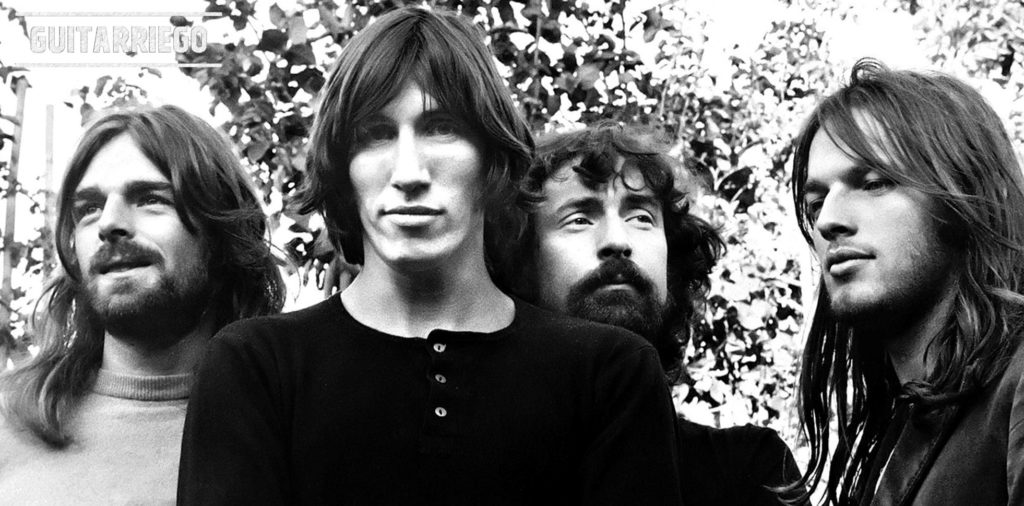
Roger Waters and his conflict with Richard Wright
While Roger got on badly with Gilmour and Ezrin, they weren’t the only ones. Waters couldn’t stand that Wright wanted to get involved in the production. The bassist could not forgive him for spending the day in the studio close to Ezrin and he “giving his opinion on everything” was a “nosy” for Waters. Which apparently irritated not only the bass player quite a bit, but also the producer.
During a few days off, Waters directed the manager to contact Wright, who was on vacation with his family, and inform him that he was out of the band. Unsurprisingly, Wright refused to leave and Waters threatened him: either he would leave the band peacefully at the end of the recording or The Wall would not be released as a Pink Floyd album. Wright was ultimately left with no other choice and accepted. But Richard asked to play the tour, for which he was assigned a salary.
Roger, despising the skill of his colleagues as musicians and instrumentalists, requested the participation of session musicians. This is how Jeff Porcaro de Toto played drums on the ballad Mother, and guitarist Lee Ritenour played on the rock song Run like hell.
Pink Floyd in Bankruptcy
As if the band’s problems were few, the excessive ostentation of their tours had left Pink Floyd bankrupt. Their lawyer advised them that the only solution to avoid losing everything was to abandon their residence in the UK and not return for 365 days. Thus, they had to earn as much as possible outside the country to be free from the excessively high British taxes. Thus, The wall was recorded in France, New York and Los Angeles.
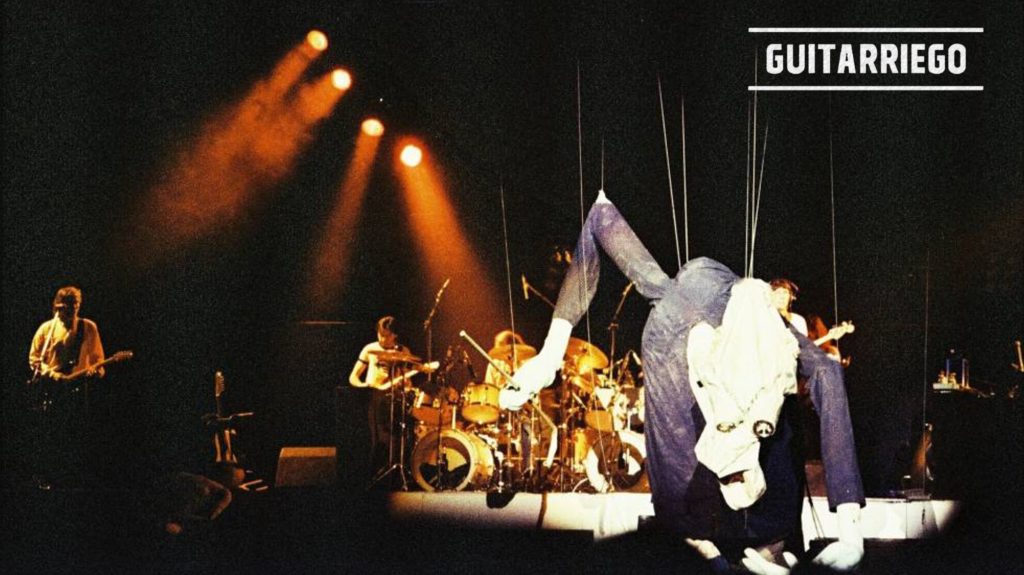
With the new single Another brick in the wall part 2, the album was a success. This song became a hit that reached number one in the United States Ranking in January 1980, staying at the position for 15 weeks. With this success at the top, it was time to go on tour to present the album.
The Wall show and its influence
Roger didn’t want a tour as such; He was aware that his extravagant ideas could not go around the world, not at least without incurring an inordinate expense. Still, many consider The Wall’s pseudo-tour the most obvious precedent for later macro shows by other music groups, such as the Rolling Stones’ Steel Wheels from 1989-1990 or U2‘s Zoo TV from 1992-1993.
The Wall concerts are a delusional theatrical frenzy. Thus, in Another brick appears the inflatable figure of the school teacher, 14 meters high. In the song Mother, the 10-meter woman. Also, animations created by the renowned artist Gerald Scarfe are projected.
They had a DJ who animated the preview of the concert, making it a real party. They had a choir of four singers and even a “fake” band that wore masks with the faces of the real members. This band appeared on the scene at first, disorienting the public who thought it was the real band.
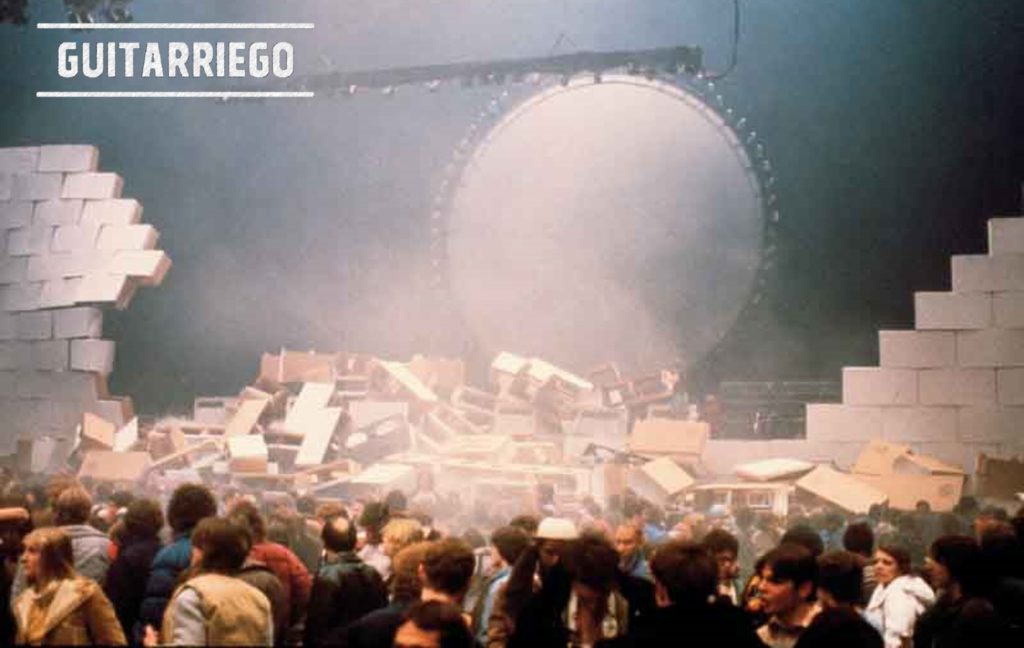
However, the most emblematic and striking thing was the construction of the wall of huge stone bricks – made of cardboard – live, which ends up completely covering the band. Finally, in a dramatic grand finale, the wall is knocked down. That same show Roger took him around the world with his solo band.
The Wall, the Rock opera
Marc Brickman, the lighting director has expressed what he felt when he was presented with The Wall project:
“It was amazing, I was speechless. They were putting on an opera at a rock and roll show. In 1980 you couldn’t even dream of that show. “
Marc brickman
Live accident at The Wall recital
At the first concert, part of the curtain caught fire and fell on top of the musicians. Half the audience fled in terror; the other half stayed, thinking it was part of the show.
Roger Waters’ misgivings
Producer Bob Ezrin was banned from the concerts, after a Billboard article suggested, to Waters’ surprise, that Bob had played a prominent role in the genesis of the tour. Despite the veto, the producer bought his ticket, arrived in a limousine and after seeing him confessed to biographer Mark Blake: “It was the best rock show I have ever seen.”

Growing tension between the band members
Little by little, the tension between Waters, Gilmour, Mason and Wright grew during the tour. “They were getting to the point where they couldn’t be seen,” said Mark Fisher, the architect who designed the set. They lost money at every concert except for Wright, who was hired at a fixed salary. Tickets were sold for an average of $ 12, which did not compensate for the expense derived from the wide range of technical and human resources. The finding of the indentation did not help to smooth things over.
The mystique around the Wall
The fact that no official videos of the great event were released has contributed to giving it an aura of mysticism. Following Waters’ designs, in 1982 the film version of the Pink Floyd album was released. The Wall, directed by Alan Parker and featuring Scarfe’s animations.
Of the double disc, 33 million units have been sold to date.

Roger and the subsequent recitals of The Wall
In July 1990, Waters gave the concert The wall live to 350,000 people in Berlin to celebrate the fall of the wall; then in 2010 he organized a tour called the same to commemorate the 30th anniversary of the tour. Recall that in 1983 Waters had said goodbye to Pink Floyd on the album The final cut.
The relationship between Waters and Gilmour the following years
The relationship between Waters and Gilmour has been practically null and totally distant for years. In 2005 they put aside their differences to act together as Pink Floyd on Live 8, and in 2010 they teamed up for a mini-performance in the UK to benefit Palestinian children.
The following year, Gilmour appeared at a Waters concert in London to perform Comfortably numb, one of The Wall’s flagship songs), but when the guitarist organized an event in honor of Wright in 2014 – who died in 2008 – he did not have his old adversary. “It’s a mystery to me why someone can pretend to do something with it,” Gilmour said. “I was in my thirties when Roger left the group. Now I am 68 – currently 74-. Half of my life has passed. There is nothing we have in common anymore, “he added.
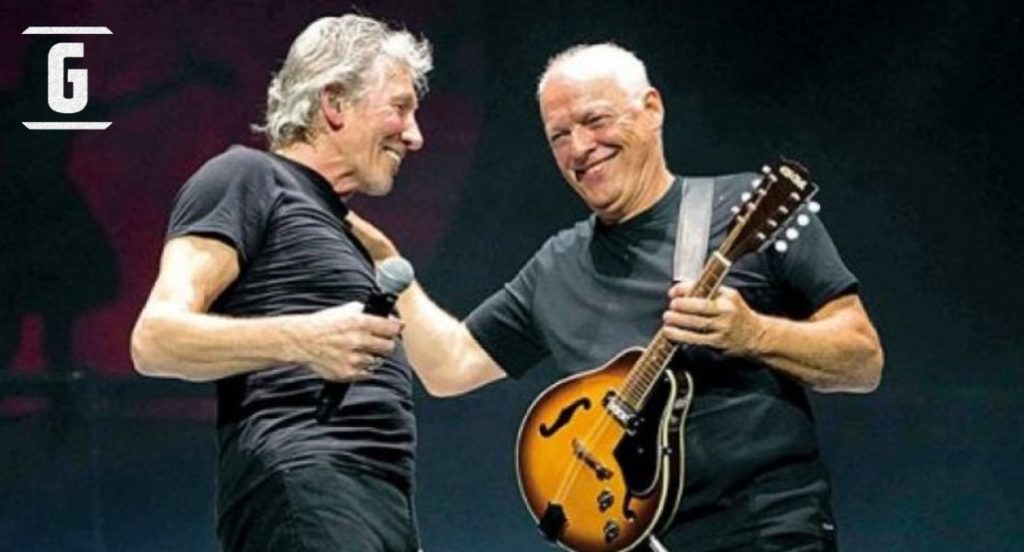
Pink Floyd’s last album was The endless river from 2014, billed by the trio Gilmour, Mason and Wright, the latter appearing posthumously. Gilmour and Waters continue to record solo, and no one thinks of a reunion of the classic Pink Floyd lineup with the band’s survivors.
Related Post: David Gilmour’s Black Strat, and its incredible story.
For more information about this, visit Pink Floyd | The Official Site.
You can share opinions or also chat about this and more with other musicians in our comments section.






